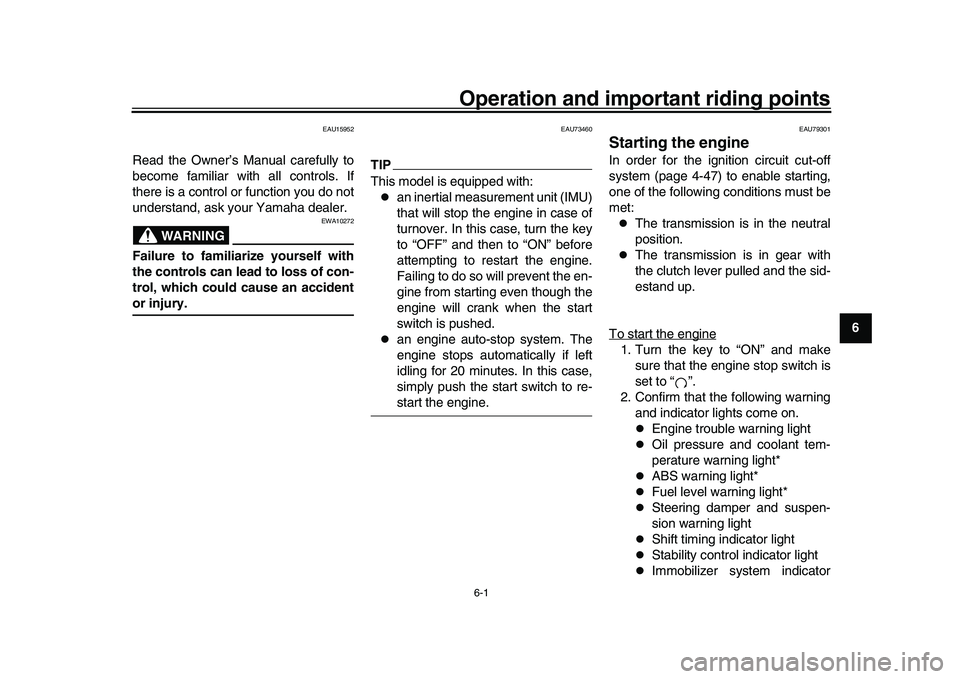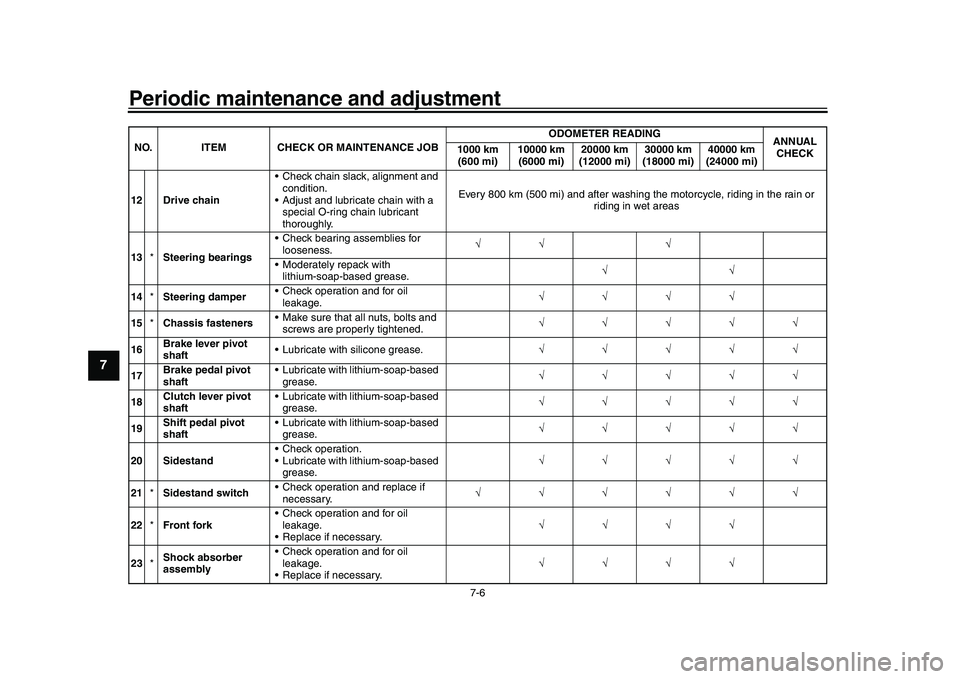2017 YAMAHA YZF-R1 oil
[x] Cancel search: oilPage 70 of 130

5-1
1
2
3
45
6
7
8
9
10
11
12
For your safety – pre-operation checks
EAU15599
Inspect your vehicle each time you use it to make sure the vehi cle is in safe operating condition. Always follow the inspection
and maintenance procedures and schedules described in the Owner’s Manual.
WARNING
EWA11152
Failure to inspect or maintain the vehicle properly increases the possibility of an accident or equipment damage.
Do not operate the vehicle if you find any problem. If a problem cannot be corrected by the procedures provided inthis manual, have the vehicle inspected by a Yamaha dealer.
Before using this vehicle, check the following points:
ITEM CHECKS PAGE
Fuel Check fuel level in fuel tank.
Refuel if necessary.
Check fuel line for leakage.
Check fuel tank breather hose and overflow hose for obstructions, cracks or
damage, and check hose connections. 4-34, 4-36
Engine oil Check oil level in engine.
If necessary, add recommended oil to specified level.
Check vehicle for oil leakage. 7-13
Coolant Check coolant level in reservoir.
If necessary, add recommended coolant to specified level.
Check cooling system for leakage. 7-16
Front brake Check operation.
If soft or spongy, have Yamaha dealer bleed hydraulic system.
Check brake pads for wear.
Replace if necessary.
Check fluid level in reservoir.
If necessary, add specified brake fluid to specified level.
Check hydraulic system for leakage. 7-25
BX4-9-E0.book 1 ページ 2016年12月1日 木曜日 午後8時7分
Page 73 of 130

6-1
1
2
3
4
567
8
9
10
11
12
Operation and important riding points
EAU15952
Read the Owner’s Manual carefully to
become familiar with all controls. If
there is a control or function you do not
understand, ask your Yamaha dealer.
WARNING
EWA10272
Failure to familiarize yourself with
the controls can lead to loss of con-
trol, which could cause an accidentor injury.
EAU73460
TIPThis model is equipped with:
an inertial measurement unit (IMU)
that will stop the engine in case of
turnover. In this case, turn the key
to “OFF” and then to “ON” before
attempting to restart the engine.
Failing to do so will prevent the en-
gine from starting even though the
engine will crank when the start
switch is pushed.
an engine auto-stop system. The
engine stops automatically if left
idling for 20 minutes. In this case,
simply push the start switch to re-start the engine.
EAU79301
Starting the engineIn order for the ignition circuit cut-off
system (page 4-47) to enable starting,
one of the following conditions must be
met:
The transmission is in the neutral
position.
The transmission is in gear with
the clutch lever pulled and the sid-
estand up.
To start the engine
1. Turn the key to “ON” and make sure that the engine stop switch is
set to “ ”.
2. Confirm that the following warning and indicator lights come on.
Engine trouble warning light
Oil pressure and coolant tem-
perature warning light*
ABS warning light*
Fuel level warning light*
Steering damper and suspen-
sion warning light
Shift timing indicator light
Stability control indicator light
Immobilizer system indicator
BX4-9-E0.book 1 ページ 2016年12月1日 木曜日 午後8時7分
Page 74 of 130

Operation and important riding points
6-2
1
2
3
4
56
7
8
9
10
11
12 light
TIP
The ABS warning light should
come on and stay on until the vehi-
cle reaches a traveling speed of 10
km/h (6 mi/h).
The oil pressure and coolant tem-
perature warning light should
come on, go off briefly, and then
remain on until the engine is start-
ed.
The fuel level warning light will stayon if you are low on fuel.
NOTICE
ECA24110
If a warning or indicator light does
not work as described above, have aYamaha dealer check the vehicle.
3. Shift the transmission into the neu- tral position (or hold the clutch le-
ver pulled with the sidestand up).
4. Push the start switch, and release it when the engine starts.
If the engine does not start within 5
seconds of pressing the start
switch, wait 10 seconds before
pressing the switch again to allow the battery voltage to restore.
NOTICE
ECA11043
For maximum engine life, never ac-
celerate hard when the engine iscold!
EAU67080
ShiftingShifting gears lets you control the
amount of engine power available for
starting off, accelerating, climbing hills,
etc.
The gear positions are shown in the il-
lustration.TIPFor speedy upshifts, turn on the quick
shift system. See QSS on page 4-17 formore information.NOTICE
ECA22520
Even with the transmission in
1. Shift pedal
2. Neutral position
1
1
2
2 3 4
5 6
N
BX4-9-E0.book 2 ページ 2016年12月1日 木曜日 午後8時7分
Page 75 of 130

Operation and important riding points
6-3
1
2
3
4
567
8
9
10
11
12
the neutral position, do not
coast for long periods of time
with the engine off, and do not
tow the motorcycle for long dis-
tances. The transmission is
properly lubricated only when
the engine is running. Inade-
quate lubrication may damage
the transmission.
Except when upshifting with the
QSS turned on, always use the
clutch while changing gears to
avoid damaging the engine,
transmission, and drive train,
which are not designed to with-
stand the shock of forced shift-ing.
EAU16811
Tips for reducing fuel
consumptionFuel consumption depends largely on
your riding style. Consider the following
tips to reduce fuel consumption:
Shift up swiftly, and avoid high en-
gine speeds during acceleration.
Do not rev the engine while shifting
down, and avoid high engine
speeds with no load on the engine.
Turn the engine off instead of let-
ting it idle for an extended length of
time (e.g., in traffic jams, at traffic
lights or at railroad crossings).
EAU16842
Engine break-inThere is never a more important period
in the life of your engine than the period
between 0 and 1600 km (1000 mi). For
this reason, you should read the follow-
ing material carefully.
Since the engine is brand new, do not
put an excessive load on it for the first
1600 km (1000 mi). The various parts in
the engine wear and polish themselves
to the correct operating clearances.
During this period, prolonged full-throt-
tle operation or any condition that might
result in engine overheating must be
avoided.
EAU17085
0–1000 km (0–600 mi)
Avoid prolonged operation above 7000
r/min.
NOTICE: After 1000 km (600
mi) of operation, the engine oil must
be changed and the oil filter car-
tridge or element replaced.
[ECA10303]
1000–1600 km (600–1000 mi)
Avoid prolonged operation above 8400
BX4-9-E0.book 3 ページ 2016年12月1日 木曜日 午後8時7分
Page 82 of 130

Periodic maintenance and adjustment
7-6
1
2
3
4
5
67
8
9
10
11
12
12 Drive chain Check chain slack, alignment and
condition.
Adjust and lubricate chain with a special O-ring chain lubricant
thoroughly. Every 800 km (500 mi) and after washing the motorcycle, riding in the rain or
riding in wet areas
13 *Steering bearings Check bearing assemblies for
looseness.
Moderately repack with lithium-soap-based grease.
14 *Steering damper Check operation and for oil
leakage.
15 *Chassis fasteners Make sure that all nuts, bolts and
screws are properly tightened.
16 Brake lever pivot
shaft Lubricate with silicone grease.
17 Brake pedal pivot
shaft Lubricate with lithium-soap-based
grease.
18 Clutch lever pivot
shaft Lubricate with lithium-soap-based
grease.
19 Shift pedal pivot
shaft Lubricate with lithium-soap-based
grease.
20 Sidestand Check operation.
Lubricate with lithium-soap-based
grease.
21 *Sidestand switch Check operation and replace if
necessary.
22 *Front fork Check operation and for oil
leakage.
Replace if necessary.
23 *Shock absorber
assembly Check operation and for oil
leakage.
Replace if necessary.
NO. ITEM CHECK OR MAINTENANCE JOB
ODOMETER READING
ANNUAL
CHECK
1000 km
(600 mi) 10000 km
(6000 mi) 20000 km
(12000 mi) 30000 km
(18000 mi) 40000 km
(24000 mi)BX4-9-E0.book 6 ページ 2016年12月1日 木曜日 午後8時7分
Page 83 of 130

Periodic maintenance and adjustment
7-7
1
2
3
4
5
678
9
10
11
12
24 *Rear suspension
relay arm and
connecting arm
pivoting points Check operation.
25 Engine oil Change (warm engine before
draining).
Check oil level and vehicle for oil leakage.
26 Engine oil filter
cartridge Replace.
27 *Cooling system Check coolant level and vehicle
for coolant leakage.
Change. Every 3 years
28 *EXUP system Check operation, cable free play
and pulley position.
29 *Front and rear brake
switches Check operation.
30 *Moving parts and
cables Lubricate.
31 *Throttle grip
housing and cable Check operation and free play.
Adjust the throttle cable free play
if necessary.
Lubricate the throttle grip housing and cable.
32 *Lights, signals and
switches Check operation.
Adjust headlight beam.
NO. ITEM CHECK OR MAINTENANCE JOB
ODOMETER READING
ANNUAL
CHECK
1000 km
(600 mi) 10000 km
(6000 mi) 20000 km
(12000 mi) 30000 km
(18000 mi) 40000 km
(24000 mi)
BX4-9-E0.book 7 ページ 2016年12月1日 木曜日 午後8時7分
Page 84 of 130

Periodic maintenance and adjustment
7-8
1
2
3
4
5
67
8
9
10
11
12
EAU72811
TIP
Air filter
This model’s air filter uses a disposable oil-coated paper element. This el ement cannot be cleaned with compressed
air, doing so will only damage it.
The air filter element needs to be replaced more fr equently when riding in unusually wet or dusty areas.
Hydraulic brake service
Regularly check the front and rear brake fluid levels. Replenish if necessary.
Every two years replace the rear brake master cylinder, the internal components of the front brake master cylinder, the brake calipers, and change the brake fluid.
Replace the brake hoses every four years or sooner if cracked, damaged, or if any section of the stainless steel brakehose has turned black.
BX4-9-E0.book 8 ページ 2016年12月1日 木曜日 午後8時7分
Page 88 of 130

Periodic maintenance and adjustment
7-12
1
2
3
4
5
67
8
9
10
11
12
EAU67110
Checking the spark plugsThe spark plugs are important engine
components, which should be checked
periodically, preferably by a Yamaha
dealer. Since heat and deposits will
cause any spark plug to slowly erode,
they should be removed and checked
in accordance with the periodic mainte-
nance and lubrication chart. In addition,
the condition of the spark plugs can re-
veal the condition of the engine.
The porcelain insulator around the cen-
ter electrode of each spark plug should
be a medium-to-light tan (the ideal color
when the vehicle is ridden normally),
and all spark plugs installed in the en-
gine should have the same color. If any
spark plug shows a distinctly different
color, the engine could be operating im-
properly. Do not attempt to diagnose
such problems yourself. Instead, have
a Yamaha dealer check the vehicle.
If a spark plug shows signs of electrode
erosion and excessive carbon or other
deposits, it should be replaced. Before installing a spark plug, the spark
plug gap should be measured with a
wire thickness gauge and, if necessary,
adjusted to specification.
Clean the surface of the spark plug
gasket and its mating surface, and then
wipe off any grime from the spark plug
threads.
NOTICE
ECA10841
Do not use any tools to remove or in-
stall the spark plug cap, otherwise
the ignition coil coupler may get
damaged. The spark plug cap may
be difficult to remove because the
rubber seal on the end of the cap fits
tightly. To remove the spark plug
cap, simply twist it back and forth
while pulling it out; to install it, twistit back and forth while pushing it in.
Specified spark plug:
NGK/LMAR9E-J
1. Spark plug gapSpark plug gap: 0.6–0.7 mm (0.024–0.028 in)
Tightening torque: Spark plug (new):18 N·m (1.8 kgf·m, 13 lb·ft)
Spark plug (after checking):
13 N·m (1.3 kgf·m, 9.4 lb·ft)
1
1
BX4-9-E0.book 12 ページ 2016年12月1日 木曜日 午後8時7分